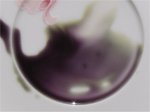Hi guys.
Just tested some pills for a friend. The results with Marquis was purple, with green on the edges of the regent, and more noticeable as the regent was "spread".
Could that indicate MD** + 2-CB?
Picture below @ about 90 seconds of regent being added to sample.
Thankyou.
Just tested some pills for a friend. The results with Marquis was purple, with green on the edges of the regent, and more noticeable as the regent was "spread".
Could that indicate MD** + 2-CB?
Picture below @ about 90 seconds of regent being added to sample.
Thankyou.


